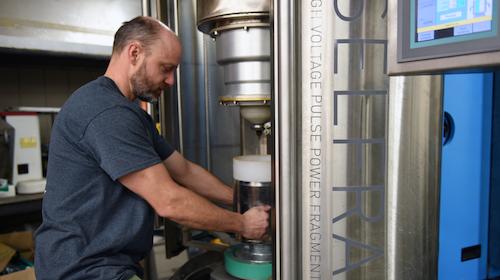Right now, UMD is a temporary home for a High Voltage Pulse Power Fragmentation machine, one of only two such devices in the whole country. “This is such a great opportunity,” said Schardt. “We can try it on a wide variety of natural and man-made materials and get the samples’ ingredients in their pure form.”
So what does the machine do exactly? Simply place something that does not float into its container along with water and once everything is sealed, it will pulse 180,000 volts into the material at the touch of a button. The pulse then breaks up the inserted material into smaller pieces without having to grind or crush it.
Schardt is a professor in the Swenson College of Science and Engineering (SCSE) Earth and Environmental Sciences Department, so for him, it is especially useful in breaking up rock samples. It’s a significant advancement because when testing sulfide ore, for example, it can break up the rock while simultaneously separating out the different minerals.
“It’s a touch free method of breaking rock, and by separating out the sulfide parts it could help create a waste material that is more or less sulfide free and environmentally neutral,” said Schardt. “It could be used in a wide range of applications, whether it’s for research, age dating rock samples or actual mining processes.”
Schardt already has three UMD students working with the machine to conduct research projects. He has also let many other researchers know of the machine’s availability so they can take advantage of this half million dollar equipment while it’s being housed at the Natural Resources Research Institute (NRRI). He’s hoping to have it until the end of February and that he can eventually obtain grant funds to purchase one for UMD. Right now, sending rock samples away to be tested can cost up to $900 per sample and this would allow for similar testing on campus.
“There are so many opportunities,” said Schardt. “Could we reprocess tailings with a machine like this? Could we use this on a larger scale for mining itself? The Civil Engineering department is eager to try out this machine, too, to see if they can create new materials for making concrete.”
For more info, see Swenson College of Science and Engineering.
